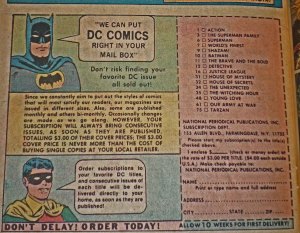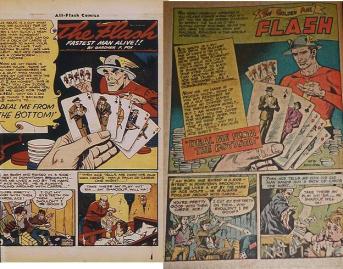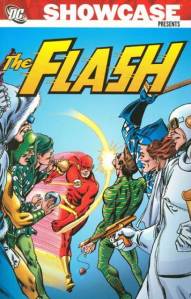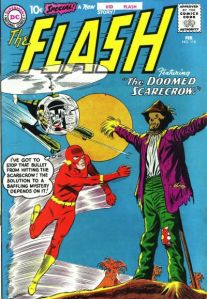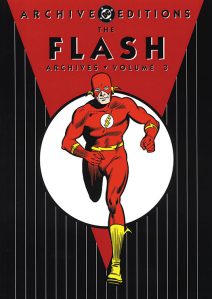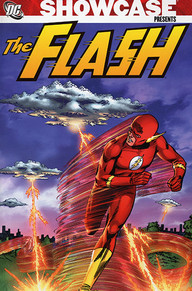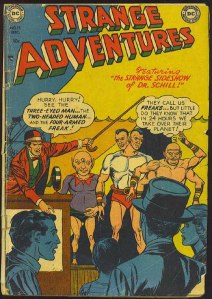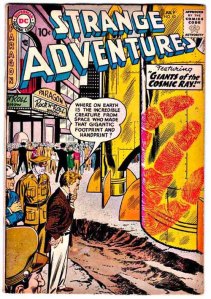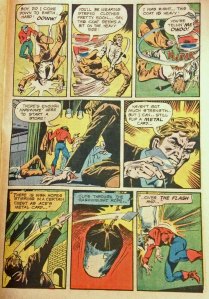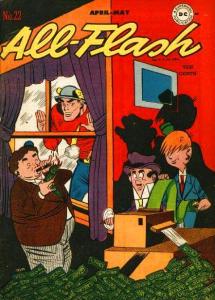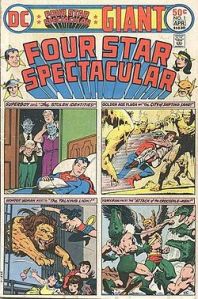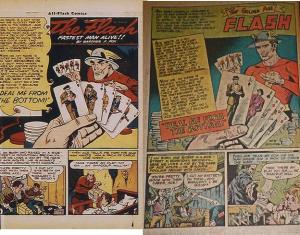DC SALUTES THE BICENTENNIAL
Tale of the Tape
This is for all the number crunchers …
Tally:
Of the 33 Bicentennial comics …
July issues: 12
August issues: 21
50-cent issues: 5
35-cent issues: 28
Bi-monthly issues: 20
Monthly issues: 11
9-times-a-year: 2 (Superboy/Legion and World’s Finest)
***
Comic books were “required by law” to publish an annual sales statement, including individual issues sold closest to the reporting month. Here are the comics I have during that reporting month from 1976 that stated their individual sales figures.
| Brave & Bold |
151,000 |
| JLA |
193,000 |
| World’s Finest |
132,185 |
| Adventure |
104,309 |
| Superman |
216,122 |
| Superman Family |
156,636 |
***
Editors:
Denny O’Neil edited one comic
Nelson Bridwell two
Gerry Conway, five
Joe Kubert, three
Julius Schwartz, seven
Murray Boltinoff, seven
Joe Orlando led them all with eight comics
***
Cover artists:
Bob Oksner
Dave Manak
Keith Giffen
Ricardo Villagran
Jose Luis Garcia Lopez, two including one with Bob Wiacek
Mike Grell, two
Jim Aparo, two
Luis Dominguez, three
Joe Kubert, four
Dick Giordano, five issues, including one with Terry Austin
Ernie Chua drew an astounding ten issues
***
Writers: keep in mind there are more than 33 writers here, that’s because obviously many comics had two (or three or sometimes more) stories per issue. Some comics, such as Ghosts, did not list the writers, and neither Grand Comics Database nor DC Comics Database list authors for that issue.
Barry Jameson
Bart Regan (two)
Bob Haney (three)
Bob Rozakis (two, including one with Michael Uslan)
Cary Bates (three)
Dave Wood
David Anthony Kraft
David Michelinie
David V. Reed
Denny O’Neil
Don Cameron & Joe Samachson
Elliot S! Maggin (three)
Gardner Fox (two reprints)
George Kashdan (two)
Jack Oleck
John Broome (two reprints)
Len Wein
Martin Pasko (two, NOT counting two more with Gerry Conway and Paul Levitz)
Michael Fleisher
Russ Manning
Sheldon Meyer (a reprint)
Steve Skeates
Weshley Marsh (Murray Boltinoff)
Gerry Conway (seven, including one with Marty Pasko)
Robert Kanigher (our leader with nine total stories written in the 33 comics)
Did I miss any? Wouldn’t surprise me…
***
Artists: as with the writers category there are more than 33 artists here, that’s because obviously many comics had two (or three or sometimes more) stories per issue
Buddy Gernale
Carmine Infantino (two reprints)
Chic Stone and Mike Royer
Curt Swan (three, including one with John Calnan)
Dick Dillin & Frank McLaughlin
Don Perlin
ER Cruz
Ernie Chua (two including one with Tex Blaisdell)
Nestor Redondo (and/or his studio)
Franc C Reyes
Fred Carillo
Gene Ureta
George Evans
George Molintorni
Gil Kane & Sid Greene (reprint)
Irv Novick (two, one with Ted Baisdell)
Jerry Robinson (reprint)
Jess Jodloman
Jim Aparo (two)
Jim Mooney (a).
José Delbo
Jose Luis Garcia Lopez (two, one with Bob Oksner)
Keith Giffen & Wally Wood
Keith Griffin, Ricardo Villagran and Oscar Novelle & Luis Dominguez
Mike Grell
Mike Kaluta (reprint)
Noly Zamora
Pablo Marcos
Pablo Marcos & Bob Smith
Paul Kruchner and Tex Blasdell
Ricardo Villamonte
Rich Buckler
Rico Rival
Romana Fradon & Juan Canale,
Ross Andru & Mike Esposito
Rubeny
Ruby Florese
Russ Manning
Sam Glanzman
Sheldon Moldoff (reprint)
Terry Hensen
Ric Estrada (an amazing 8, which includes 2 with Joe Staton and one with Al Milgrom – with that many comics I can imagine he would need the help!)
***
Comics, especially from the Big Two, rarely have letter columns in these days of email and Instant Messaging. I think that’s a shame. But letter columns made up an integral part of a comic book – it’s how fans kept in touch with one another. Some fans became professionals simply because their letter writing gave them name recognition at hiring time (Bob Rozakis for one) – it helped that the letter writers (Bob included) were also talented! One wonders how many hacks were turned away – “but I had 46 letters published!” “Your letter writing skill is good, that’s true, but as a comic book fiction writer … you stink.” The only future comic book talent from the letter writers of these July 1976 comics that I recognize is Bob Rodi (from Karate Kid #3).
“Hey!” I write for comics and I’m on that list! Oops, sorry I didn’t recognize the name. What comics do you write/draw/etc. for? I’d love to read them!
I left out anonymous and obvious fake names. Here are, I think, all of them:
The most prolific writers were Mike White, who appeared in 7 issues (nearly one third of the comics) and Fred Schneider in 5 issues.
Adam Castro of New Rochelle, NY (3 letters total)
Arthur Grance of Staten Island, NY
Arthur Kowalik of Wilmington, DE
Barry Charles of Louisville, KY
Bart Casey of Dayton, Ohio
Bob Robinson, Lincoln, NE
Bob Rodi of Columbia, MO
Brian Dyke of Goodlettsville, TN
Brian Scott of Streator, IL
Burt Fowler of Jacksonville, FL
Cadet Captain Ruby S Nelson of Jacksonville, AL
Carlton McDaniels of New York
Clifford Gerstman of New York, NY
Craig Kenner of Massillon, OH
Damian Brokaw of Denver, CO
Dan Cardenas, San Luis Obispo, CA
Dave Wilcox, Arlington Heights, IL
David A Jones of Horse Cave, KY
David B. Kirby of Richmond, VA
David Hanson of Swartz Creek, Mich.
David J. Brown of Hammond, IN
David L Klees of Newton Centre, Mass
David Trenton of New York, NY
DK Thomas of Brunswick, ME
Doil Ward of Ardmore TX
Don Vaughn of Lake Worth, FL
Drury Moore of Springfield, IL
Edward Wojcik of Detroit, Michigan
Elizabeth Smith of Tacoma Washington
Eric Ehrlich of North Platte, NE
FL Watkins, Champaign, IL
Fred Schneider of New York (6 issues)
Gerald Duit of New Orleans, LA
Glenn Rowsam of Oakland, CA
Hugh J. Leach, Mason, MI
Charles Backman of Sterling Heights, MI
Jack Gregotz, Mayfield Heights, OH
James Parker of Clarksville, TN
Janet Fadel of Hollywood, CA
Jeff Sporn of Bethesda, MD
Jerry Rosen of New York, NY
Jim Dever of Philadelphia, PA
Jim Humm of El Monte, CA
Jim Planack of Poughkeepsie, NY
Jimmy Holcomb of Mesquite, TX
Joe Peluso, Brooklyn, NY
John Baker of Baltimore, MD
John Elliot, New York, NY (3 letters)
John Jesse of Hobart, IN
Jonathan Kuntz, Los Angeles, CA
Judy Newton of Thompkinsville, RI
Katie Raisler of East Lansing, MI
Ken Kemble of San Antonio, TX
Ken Regalado, South Pasadena, CA
Kevin L. Callahan, Brea, CA (3 issues)
Kirk Anderson of DeForest, WI
Linas Sabalys of Laval, PQ, Canada (3 issues)
Louis A, Latzer of St. Louis, MO
Marie Munas of La Mesa, CA
Mark McIntyre of Atlanta, GA
Mark Schmeider, Concord, Mass (5 issues)
Mark Wannop of Camden, NJ
Mark Zutkoff, Timoniom, MD
Mary E. ReCasino, Vernon, CT
Matthew Elyosin, Madison, CT
Michael D Dargay of Royal Oak, MI (3 issues)
Michael Lapsley of Morrow, GA
Mike Karvalas of Chicago, IL
Mike Thompson of Lockemup Prison
Mike White of Mackinaw, IL (the most: 7 issues)
Paul Emrath of Milwaukee, WI (3 issues)
Paulo Mariorann of Parma, Ontario
Peter Sanderson of New York, NY
Robert Gustive of Grand Island, Neb
Robert LaChine of Chicago, IL
Robert Vias, Dover, NJ
Robert W. Chan of Edmonton, Canada
Rod McLaughlin of Ramsey, Mont.
Roger Thomas Enevoldesen, North Augusta, SC
Ron Lindsey of Augusta, GA
Ronald M. Fitz, Valparaiso, IN
Sam MCHendley of Berkeley, CA
Sarah Finnegan of Washington DC
Scott Gibson of Evergreen CO (5 issues)
Scott R. Taylor of Portland, TX (3 issues)
Steve Kalaitzidis of Toronto, Ontario
Teddy Arnold of Houston TX
Terry Chadwick of Phoenix, AZ
Thomas Edward Bigham of Matt, Mass
Thomas Russon of Mt. Kisco, NY
Tim Corrigan, Rochester, NY
Tom Kelleher of Norwalk, Conn.
Tom Weyandt of Broadtop City, PA
Wade Sears of Calgary, Alberta
Walter Green of Wading River, NY
***
Thanks for reading the blog series. It was as much fun to read (and re-read) these comics as it was to comment about them.
My father would bring home stacks and stacks of DC comics for me. He worked for the Air Force, but some of his staff’s spouses worked for Sparta Printing – where they used to give away comics to the employees by the truckload. It was literally, “your boss has a kid? Here!” {thud}
Doing this blog series reminded me of that. I had a stack of comics next to my chair. I also had a notepad and pen to make notes. But at times I imagined my dad bringing home these 33 comics for me to enjoy.
This blog series is dedicated to him.
Original Material copyright 2015 Michael Curry
Images used are copyright their respective holders and and reproduced here under the “fair Use” doctrine of 17 USC 106 & 106a for the purposes of criticism and comment.







